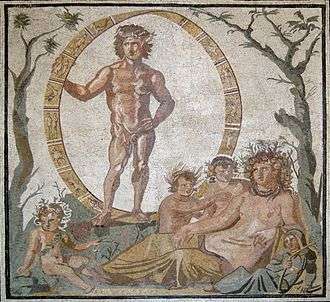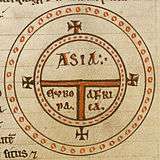Earth symbol



A variety of symbols or iconographic conventions are used to represent Earth, either in the sense of planet Earth, or the inhabited world or the classical element in alchemy, or as chthonic principle in mythology, mysticism and psychoanalysis.
The earliest type of symbols are allegories, personifications or deifications, mostly in the form of an Earth goddess (in the case of Egyptian mythology a god, Geb).
|
|
The classical element "Earth" is represented by the trigram of three broken lines in the I Ching (☷ U+2637). The Western (early modern) alchemical symbol is a downward-pointing triangle bisected by a horizontal line. Other symbols for the earth in alchemy or mysticism include the square and the serpent.[1]
In the Roman period, the globe, a representation of the spherical Earth, became the main symbol representing the concept. The globe depicted the "universe" (pictured as the celestial sphere) as well as the Earth. The globus cruciger is the globe surmounted by a Christian cross, used in the Byzantine Empire to represent the Christian ecumene. In the medieval period, the known world was also represented by the T-and-O figure, representing an extremely simplified world map of the three classical continents of the Old World, viz. Asia, Europe and Africa.
Representations of the globe of Earth, either with an indication of the shape of the continents or with a representation of meridians and parallels remains a common pictographic convention to express the notion of "worldwide, global".
The modern astronomical symbol for Earth as a planet uses either a stylized globus cruciger (U+2641 ♁) or a circle with a cross (representing the equator and one meridian; U+1F728 (🜨).[2][3]
Unicode has introduced a four characters representing the "globe" in the Miscellaneous Symbols and Pictographs block:
- EARTH GLOBE EUROPE-AFRICA U+1F30D 🌍
- EARTH GLOBE AMERICAS U+1F30E 🌎
- EARTH GLOBE ASIA-AUSTRALIA U+1F30F 🌏
- GLOBE WITH MERIDIANS U+1F310 🌐
See also
| Wikimedia Commons has media related to Earth symbols. |
- Planet symbols
- Earth in culture
- Globe
- Radical 32
- Terra (mythology)
- Atlas (mythology)
- Solar symbol
- Celestial sphere
- Armillary sphere
References
- ↑ Jacobi, Jolande, Complex/Archetype/Symbol In The Psychology Of C G Jung, Routledge (2013), 146, 169.
- ↑ The Penny cyclopædia of the Society for the Diffusion of Useful Knowledge. 22. C. Knight. 1842. p. 197.
- ↑ The Encyclopedia Americana: a library of universal knowledge. 26. Encyclopedia Americana Corp. 1920. pp. 162–163. Retrieved 2011-03-24.
